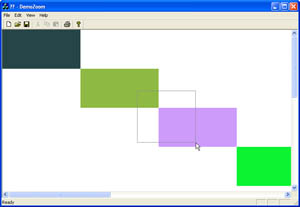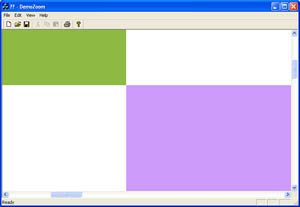|
Visual
C++ MFC Tutorials: CZoomView
/ A class that provides
"zoom" feature
|
| |
By Roonglit
Chareonsupkul.
|
 
Introduction
This class handles zooming
feature based on CScrollView.
It provides functions to set the scale of the application
easily.
Using the code
Create a Doc/View
application by using application wizard. Change your CView
class to inherit from CZoomView
instead of CView or CScrollView.
And that's it, your application has zoom
feature. When you want to set the scale of your
application, you just call SetZoomScale() method.
void CDemoZoomView::OnViewZoomin()
{
SetZoomScale(m_zoomFactor + 1.0f);
}
void CDemoZoomView::OnViewZoomout()
{
SetZoomScale(m_zoomFactor - 1.0f);
}
Points of Interest
When I started to
develop the application that wanted zoom
feature, I see other guys have to create scale variable
and multiply this variable in all drawing
functions. It is not easy to use. So, I tried to find how
to set scale in one place and that applies to all drawing
code. Fortunately, there are some mapping modes that can
set ratio between viewport and window area. And MM_ISOTROPIC
is the answer. We can set the ratio by calling SetWindowExt()
and SetViewPortExt().
int CZoomView::SetMapMode(CDC* pDC)
{
int previousMode = pDC->SetMapMode(MM_ISOTROPIC);
pDC->SetWindowExt(100,100);
pDC->SetViewportExt(FloatToInt(100*m_zoomFactor),FloatToInt(100*m_zoomFactor));
return previousMode;
}
SetWindowExt() and
SetViewPortExt() are the functions of the CDC
class. If we want them easy to use, the user should not
know what we do with the instance of the CDC
class. So, my CZoomView
has the instance of CDC class. This instance
will be sent through OnDraw() function. The
user will call normal drawing
functions and the zoom
feature will apply automatically.
Logical point and
Device point
Because CZoomView
is based on CScrollView,
so there are logical points and device points to concern. CZoomView
provides DPtoLP and LPtoDP
functions. User can use it as usual with CDC
instance.
void CDemoZoomView::OnLButtonDown(UINT nFlags, CPoint point)
{
if (m_bSelectMode == FALSE)
{
m_bSelectMode = TRUE;
m_ptStart = point;
DPtoLP(&m_ptStart);
m_rubberBand.SetRect(m_ptStart, m_ptStart);
Invalidate(FALSE);
}
CZoomView::OnLButtonDown(nFlags, point);
}
|




